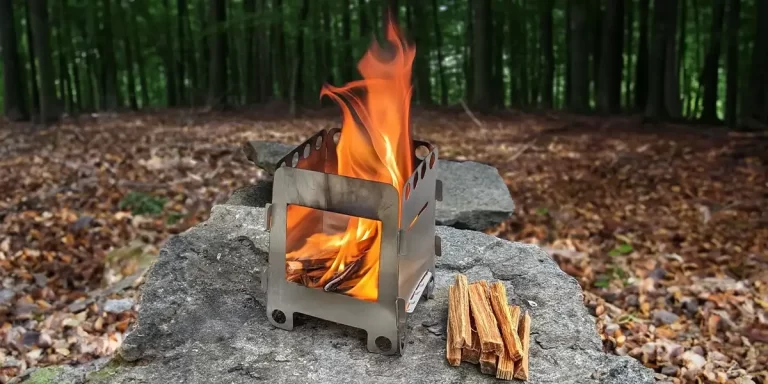

Cooking outside can be exciting, but carrying those big fuel canisters is a real pain. That’s where backpacking wood stoves come in handy.
These nifty gadgets allow you to cook without lugging around extra fuel, making them perfect for those who appreciate self-reliance and dislike the worry of running out of gas in the middle of nowhere.
Now, you might be wondering, “How to I choose a backpacking wood stove?” Well, you’re in the right place, as this post will guide you in selecting the ideal backpacking wood stove and comparing it to other available stoves.
Interested? Let’s get started.
Backpacking wood stoves come in two main types: can-style for efficiency and folding-style for portability. Now, let’s take a closer look at each:

Can-styled stoves are like mini wood-burning powerhouses. Some can-style stoves are known as wood gasifier stoves because they use a two-stage burn process, making them highly efficient. They turn wood into hot, clean-burning gas, providing more energy from a single wood load.
Pros: When comparing can-style and folding-styled wood stoves, the can-style stoves are more efficient, requiring less fuel and heating up your cooking about 30% faster. They also offer more durability.
Cons: However, it’s important to consider that can-style stoves are less packable and heavier, and they have the tendency to get sooty, which is a drawback for a stove that can’t be easily packed away.
Popular ultralight can-style stove backpacking options include:
| Make / Model | Weight oz (g) |
|---|---|
| TOAKS Titanium Wood Burning Stove (Small) | 5.29 (150) |
| TOAKS Titanium Wood Burning Stove (Regular) | 7.90 (225) |
| Solo Stove Lite Camp Stove (Stainless Steel) | 9 (255) |

Folding-style stoves are all about convenience. They collapse flat, saving precious space in your backpack. Assembling them is also a breeze, usually involving fitting sidewalls and a burn pan.
Pros: Managing soot on these stoves is easier since you can slip them into a separate bag for transport.
Cons: Although not as efficient as gasifier stoves, folding wood stoves can still boil water in about 10 minutes, making them a solid choice when you factor in the weight savings from not carrying fuel.
Popular ultralight folding-style backpacking stove options include:
| Make / Model | Weight oz (g) |
|---|---|
| EmberLit FireAnt Titanium Ultralight Backpacking Stove | 3 (85) |
| Vargo Titanium Fire Box | 3.95 (112) |
| Gram-counter Gear Titanium Wood Burning Stove | 4.02 (114) |
| Vargo Titanium Hexagon Stove | 4.05 (115) |
When selecting a stove, consider these key factors to find the most suitable option:
Consider the weather conditions, such as wind, during your travels. Read reviews if you require features like excellent pot stability, as this depends on the design of the stove itself.
You might be wondering how wood stoves are different from other options. Don’t worry, here’s a comparison table that will give you a quick overview:
| Type | Weight | Ease of Use | Fuel Source | Pros | Cons |
|---|---|---|---|---|---|
| Wood burner | Ultralight | Difficult | Foraged wood | Ultralight; Use found fuel | Tending; Fuel foraging; Hard to light |
| Canister | Moderate | Very easy | Self-contained canister | Simple ignition; Integrated design | Relatively heavy |
| Liquid fuel | Moderate | Moderate | Refillable fuel bottle | Refillable; Good for longer trips | More complex pumping and priming |
| Alcohol | Ultralight | Very easy | Alcohol fuel | Very simple and lightweight | Cool burn; Only for boiling water |
| Solid fuel | Ultralight | Easy | Fuel tablets | Lightweight and convenient | Limited burn time; Expensive per use |
If you’re interested in learning more about different types of stoves, you can check out our detailed comparison post here.
Backpacking wood stoves are the perfect companions for outdoor cooking adventures. Whether you’re a seasoned backpacker or new to the wilderness, this post equips you with the knowledge to make the most of these ingenious devices.
We’ve delved into two types of wood stoves: the efficient can-style and the portable folding-style, each offering unique benefits – choose what suits you best.
If you want to learn more about how to use a backpacking wood stove, check out our dedicated post on the topic here. That’s it. Happy cooking!
Are you on the hunt for the lightest stove option available? Check out our TOP 5 guide for the lightest stoves on the planet.
Choosing the ideal wood stove for backpacking depends on your specific needs and preferences. Compact canister wood stoves offer lightweight and portable solutions, ideal for ultralight backpacking. Alternatively, portable folding wood stoves provide versatility and efficient combustion. When deciding, consider factors like weight, cooking style, and fuel availability in your chosen backpacking destination to make the best choice for your adventures.
Using a wood-burning backpacking stove inside a tent demands caution. Ensure proper ventilation with a stovepipe, but be wary of carbon monoxide. Only light small, controlled fires, never leaving the stove unattended. Watch for poor ventilation signs, and consider cooking outside for safety. Though it might work in emergencies with proper ventilation, using this stove in open air is always safer.
When backpacking with a wood-burning stove, control the cooking temperature for best results. Aim for a simmer, around 180-200°F, to efficiently cook foods like oatmeal, pasta, or freeze-dried meals without burning. Keep the stove at a steady, low flame to maintain a consistent simmer. Avoid boiling, as it cooks food too quickly and unevenly.